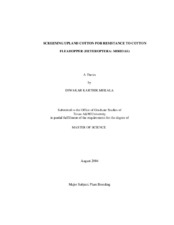| dc.description.abstract | Cotton (Gossypium hirsutum L.) crop maturity is delayed by cotton fleahopper (Pseudatomoscelis seriatus Reuter) (fleahopper) feeding on early-season fruit forms which increases vulnerability to late-season pests such as Helicoverpa zea (Boddie) and Heliothis virescens (Fabricius). The objectives of this research were to evaluate methods of screening for resistance to fleahopper and to screen selected genotypes. Six fleahoppers were caged on plants in the insectary for 72 h. Numbers of live fleahoppers and percent square damage were determined 48 h following the removal of fleahoppers. Fleahopper numbers and percent square set were determined on randomly selected plants of 16 genotypes when grown under field conditions in 2002 and 2003. Across multiple sampling dates, the number of fleahoppers per plant was higher (p=0.05) in G. arboreum and Pilose (G. hirsutum), but no consistent differences were observed among the remaining 15 genotypes which represented several germplasm pools across the United States. Field and no-choice feeding tests suggested that Pilose, Lankart 142, Suregrow 747, and Stoneville 474 were more resistant hairy-leaf genotypes and not different (p=0.05) in resistance than the smooth-leaf genotypes, Deltapine 50 and TAM 96WD-69s. Pin-head, match-head, and one-third grown squares were removed from plants and placed on agar in petri-plates. Four fleahoppers were released per plate and allowed to feed for 48 h. Fleahopper damage, brown areas along the anthers and/or brown and shrunken pollen sacs was most evident in pin-head sized squares. | en |


